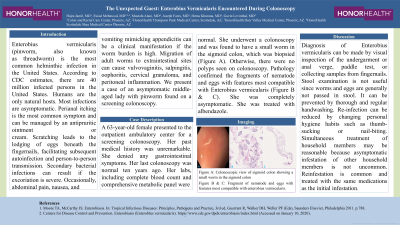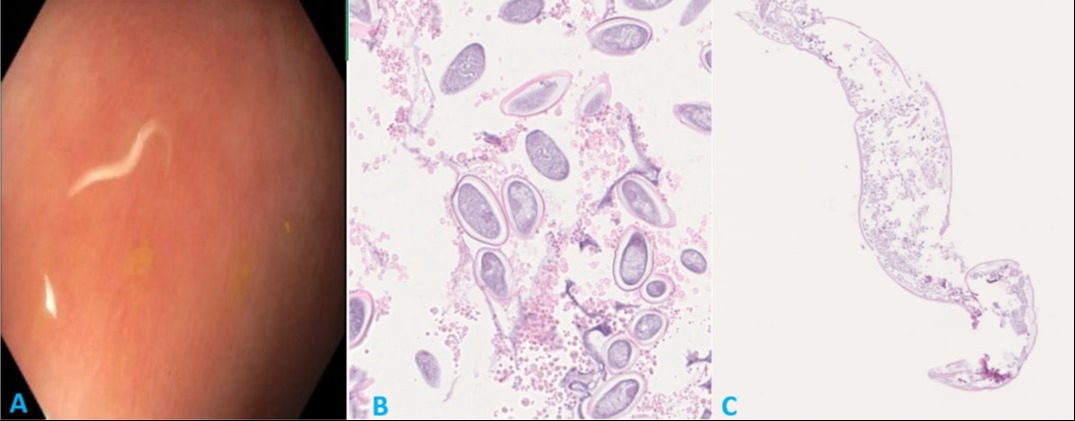Monday Poster Session
Category: Colon
P2012 - The Unexpected Guest: Enterobius Vermicularis Encountered During Colonoscopy
Monday, October 28, 2024
10:30 AM - 4:00 PM ET
Location: Exhibit Hall E

Has Audio
- FM
Faisal Mehmood, MD
HonorHealth
Glendale, AZ
Presenting Author(s)
Hajra Jamil, MD1, Faisal Mehmood, MD2, Mustafa Alani, MD3, Joseph Fares, MD4, Hema Khurana, MBBS5, Gavin Levinthal, MD4
1Services Institute of Medical Sciences, Lahore, Punjab, Pakistan; 2HonorHealth, Phoenix, AZ; 3HonorHealth Medical Group, Chandler, AZ; 4HonorHealth, Scottsdale, AZ; 5GI Pathology Consultants of Arizona, Glendale, AZ
Introduction: Enterobius vermicularis (pinworm, also known as threadworm) is the most common helminthic infection in the United States. According to CDC estimates, there are 40 million infected persons in the United States. Humans are the only natural hosts. Most infections are asymptomatic. Perianal itching is the most common symptom and can be managed by an antipruritic ointment or cream. Scratching leads to the lodging of eggs beneath the fingernails, facilitating subsequent autoinfection and person-to-person transmission. Secondary bacterial infections can result if the excoriation is severe. Occasionally, abdominal pain, nausea, and vomiting mimicking appendicitis can be a clinical manifestation if the worm burden is high. Migration of adult worms to extraintestinal sites can cause vulvovaginitis, salpingitis, oophoritis, cervical granuloma, and peritoneal inflammation. We present a case of an asymptomatic middle-aged lady with pinworm found on a screening colonoscopy.
Case Description/Methods: A 63-year-old female presented to the outpatient ambulatory center for a screening colonoscopy. Her past medical history was unremarkable. She denied any gastrointestinal symptoms. Her last colonoscopy was normal ten years ago. Her labs, including complete blood count and comprehensive metabolic panel, were normal.
She underwent a colonoscopy and was found to have a small worm in the sigmoid colon, which was biopsied (Figure A). Otherwise, there were no polyps seen on colonoscopy. Pathology confirmed the fragments of nematode and eggs with features most compatible with Enterobius vermicularis (Figure B & C). She was completely asymptomatic. She was treated with albendazole.
Discussion: Diagnosis of Enterobius vermicularis can be made by visual inspection of the undergarment or anal verge, paddle test, or collecting samples from fingernails. Stool examination is not useful since worms and eggs are generally not passed in stool. It can be prevented by thorough and regular handwashing. Re-infection can be reduced by changing personal hygiene habits such as thumb-sucking or nail-biting. Simultaneous treatment of household members may be reasonable because asymptomatic infestation of other household members is not uncommon. Reinfestation is common and treated with the same medications as the initial infestation.

Disclosures:
Hajra Jamil, MD1, Faisal Mehmood, MD2, Mustafa Alani, MD3, Joseph Fares, MD4, Hema Khurana, MBBS5, Gavin Levinthal, MD4. P2012 - The Unexpected Guest: <i>Enterobius Vermicularis</i> Encountered During Colonoscopy, ACG 2024 Annual Scientific Meeting Abstracts. Philadelphia, PA: American College of Gastroenterology.
1Services Institute of Medical Sciences, Lahore, Punjab, Pakistan; 2HonorHealth, Phoenix, AZ; 3HonorHealth Medical Group, Chandler, AZ; 4HonorHealth, Scottsdale, AZ; 5GI Pathology Consultants of Arizona, Glendale, AZ
Introduction: Enterobius vermicularis (pinworm, also known as threadworm) is the most common helminthic infection in the United States. According to CDC estimates, there are 40 million infected persons in the United States. Humans are the only natural hosts. Most infections are asymptomatic. Perianal itching is the most common symptom and can be managed by an antipruritic ointment or cream. Scratching leads to the lodging of eggs beneath the fingernails, facilitating subsequent autoinfection and person-to-person transmission. Secondary bacterial infections can result if the excoriation is severe. Occasionally, abdominal pain, nausea, and vomiting mimicking appendicitis can be a clinical manifestation if the worm burden is high. Migration of adult worms to extraintestinal sites can cause vulvovaginitis, salpingitis, oophoritis, cervical granuloma, and peritoneal inflammation. We present a case of an asymptomatic middle-aged lady with pinworm found on a screening colonoscopy.
Case Description/Methods: A 63-year-old female presented to the outpatient ambulatory center for a screening colonoscopy. Her past medical history was unremarkable. She denied any gastrointestinal symptoms. Her last colonoscopy was normal ten years ago. Her labs, including complete blood count and comprehensive metabolic panel, were normal.
She underwent a colonoscopy and was found to have a small worm in the sigmoid colon, which was biopsied (Figure A). Otherwise, there were no polyps seen on colonoscopy. Pathology confirmed the fragments of nematode and eggs with features most compatible with Enterobius vermicularis (Figure B & C). She was completely asymptomatic. She was treated with albendazole.
Discussion: Diagnosis of Enterobius vermicularis can be made by visual inspection of the undergarment or anal verge, paddle test, or collecting samples from fingernails. Stool examination is not useful since worms and eggs are generally not passed in stool. It can be prevented by thorough and regular handwashing. Re-infection can be reduced by changing personal hygiene habits such as thumb-sucking or nail-biting. Simultaneous treatment of household members may be reasonable because asymptomatic infestation of other household members is not uncommon. Reinfestation is common and treated with the same medications as the initial infestation.

Figure: Figure A: Colonoscopy view of sigmoid colon showing a small worm in the sigmoid colon
Figure B & C: Fragment of nematode and eggs with features most compatible with enterobius vermicularis.
Figure B & C: Fragment of nematode and eggs with features most compatible with enterobius vermicularis.
Disclosures:
Hajra Jamil indicated no relevant financial relationships.
Faisal Mehmood indicated no relevant financial relationships.
Mustafa Alani indicated no relevant financial relationships.
Joseph Fares indicated no relevant financial relationships.
Hema Khurana indicated no relevant financial relationships.
Gavin Levinthal indicated no relevant financial relationships.
Hajra Jamil, MD1, Faisal Mehmood, MD2, Mustafa Alani, MD3, Joseph Fares, MD4, Hema Khurana, MBBS5, Gavin Levinthal, MD4. P2012 - The Unexpected Guest: <i>Enterobius Vermicularis</i> Encountered During Colonoscopy, ACG 2024 Annual Scientific Meeting Abstracts. Philadelphia, PA: American College of Gastroenterology.
